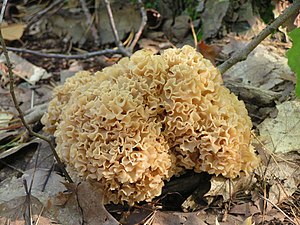Frizzy mother hen
| Frizzy mother hen | ||||||||||||
|---|---|---|---|---|---|---|---|---|---|---|---|---|

Frilled mother hen ( Sparassis crispa ) |
||||||||||||
| Systematics | ||||||||||||
|
||||||||||||
| Scientific name | ||||||||||||
| Sparassis crispa | ||||||||||||
| ( Wulfen : Fr. ) Fr. |
The cauliflower mushrooms or Fettehenne ( Sparassis crispa ) is a parasitic fungus species from the family of Gluck relatives (Sparassidaceae) whose large ocher yellowish fruiting body is edible and with his curly branches to a bath sponge recalls.
features
Macroscopic features
The fruiting body becomes 10–40 cm wide and 2 to 5 kg heavy. It has a cauliflower-like , curly structure with many branches. It is made up of individual strands that form cavities between them. The color ranges from yellowish to light brownish. When dry, the fruiting body is quite fragile. The base is thick and protrudes from the infested root wood almost like a cauliflower stalk. The flesh is whitish; it smells spicy and tastes nutty. The spore powder is pale yellow in color.
Microscopic features
The small spores are elliptical and smooth and 5-6 × 4-4.5 micrometers in size.
Species delimitation
The much rarer, but almost equally edible mother hen is quite similar . However, their wider "leaves" zoned at the top give them a less spongy appearance.
Ecology and phenology
The fructified mother hen fructifies on the base of the trunk or on stumps of conifers, especially the forest pine . Occasionally it has also been discovered on other types of pine , larch , spruce and Douglas fir . Fruiting body thrusts can appear in almost the same place for several years in a row. The fungus and its host trees can be found on a variety of soil types, but these must not be too dry or too wet.
The fungus penetrates the heartwood of the tree through damage to the roots or the lower trunk area. There it causes an intense brown rot (lignin is not broken down) up to a low altitude , the smell of which is similar to that of turpentine . The fungus can also live saprobionic in stumps for several years and attack new host trees from there.
The fruiting bodies appear from July to December, with a clear maximum in September and October.
distribution
The frilled mother hen is widespread in the Holarctic from meridional to temperate . It can be found in Asia, North America, North Africa and Europe. In Europe, the fungus prefers the heat-favored regions and is therefore mainly to be found in southern, south-eastern, western and central Europe. To the north, the distribution extends to northern Scotland and the southern coastal regions of Scandinavia, especially Sweden.
meaning
Especially in the extensive pine forests of Eastern Germany, the Krause Glucke is on the one hand an unpleasant tree spoiler for the foresters, but a common and popular edible mushroom for the mushroom pickers . The raw meat is somewhat gristly, the smell aromatic and slightly rubbery. When prepared, the mother hen is firm to the bite and tasty. The taste is similar to that of the edible morel . Even when cut, it can be kept fresh in the refrigerator for a week or more, but it can also be used in a dried form for sauces. The cleaning of the fruiting body from slightly ingrown soil residues is a bit complicated. To make things easier, it is dipped “head down” in plenty of water and cut into thick slices.
swell
literature
- German Josef Krieglsteiner (Eds.), Andreas Gminder , Wulfard Winterhoff: Die Großpilze Baden-Württemberg . Volume 2: Stand mushrooms: inguinal, club, coral and stubble mushrooms, belly mushrooms, boletus and deaf mushrooms. Ulmer, Stuttgart 2000, ISBN 3-8001-3531-0 .
Individual evidence
- ↑ a b Ewald Gerhardt: FSVO manual mushrooms . 4th edition. BLV, Munich 2006, ISBN 3-8354-0053-3 , p. 395 .
- ↑ Wolfgang Bachmeier (123pilze.de): Krause mother hen, fat hen, bear skull
Web links
- Michael Kuo: Sparassis spathulata and Sparassis crispa: The Eastern Cauliflower Mushrooms. In: MushroomExpert.Com. January 2009. Retrieved September 25, 2017 .
- Harold H. Burdsall, Orson K. Miller: Neotypification of Sparassis crispa . In: Mycotaxon . tape 31 , 2, April-June, 1988, pp. 591–593 ( PDF; 32 kB; fpl.fs.fed.us ).

